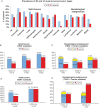Prevalence of iron deficiency across different tumors and its association with poor performance status, disease status and anemia
- PMID: 23567147
- PMCID: PMC3690908
- DOI: 10.1093/annonc/mdt118
Prevalence of iron deficiency across different tumors and its association with poor performance status, disease status and anemia
Abstract
Background: Only limited data on the prevalence of iron deficiency (ID) and its correlation with clinical parameters are available in cancer. ID frequently contributes to the pathogenesis of anemia in patients with cancer and may lead to several symptoms such as impaired physical function, weakness and fatigue.
Patients and methods: Parameters of iron status and clinical parameters were evaluated in 1528 patients with cancer who presented consecutively within a four-month period at our center. One thousand fifty-three patients had solid tumors and 475 hematological malignancies.
Results: ID [transferrin saturation (TSAT) < 20%] was noted in 645 (42.6%) of the 1513 patients with TSAT tests available and 500 (33.0%) were anemic. ID rates were highest in pancreatic (63.2%), colorectal (51.9%) and lung cancers (50.7%). Of the 409 iron-deficient patients in whom serum ferritin levels were available additionally to TSAT, 335 (81.9%) presented with functional ID (FID) (TSAT < 20%, serum ferritin ≥30 ng/ml) and 74 (18.1%) with absolute ID. In patients with solid tumors, prevalence of ID correlated with cancer stage at diagnosis (P = 0.001), disease status (P = 0.001) and ECOG performance status (P = 0.005).
Conclusions: ID was frequently noted in cancer and was associated with advanced disease, close proximity to cancer therapy, and poor performance status in patients with solid tumors.
Keywords: absolute iron deficiency; cancer-related anemia; chemotherapy-induced anemia; functional iron deficiency; iron deficiency; iron deficiency anemia.
Figures

References
-
- Ludwig H, Van BS, Barrett-Lee P, et al. The European Cancer Anaemia Survey (ECAS): a large, multinational, prospective survey defining the prevalence, incidence, and treatment of anaemia in cancer patients. Eur J Cancer. 2004;40:2293–2306. - PubMed
-
- Grotto HZ. Anaemia of cancer: an overview of mechanisms involved in its pathogenesis. Med Oncol. 2008;25:12–21. - PubMed
-
- Beale AL, Penney MD, Allison MC. The prevalence of iron deficiency among patients presenting with colorectal cancer. Colorectal Dis. 2005;7:398–402. - PubMed
-
- Beguin Y, Lybaert W, Bosly A. A prospective observational study exploring the impact of iron status on response to darbepoetin alfa in patients with chemotherapy induced anemia. Blood. 2009;114 abstract 2007.
Publication types
MeSH terms
LinkOut - more resources
Full Text Sources
Other Literature Sources

